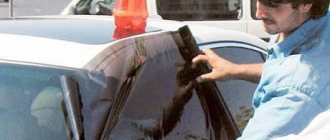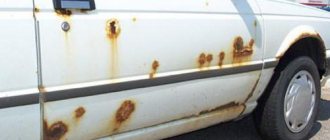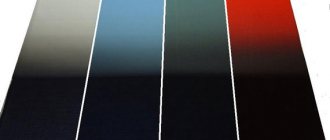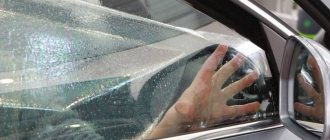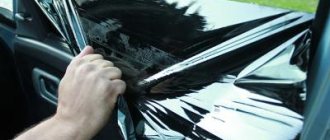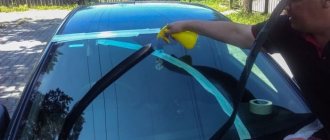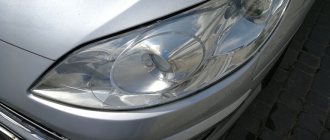Tinting car windows became popular almost as soon as the opportunity arose. Because this makes it possible to reduce such unpleasant phenomena as sunlight hitting the windshield, blinding the driver. But permitted tinting is not so simple. You need to tint your car correctly if you don’t want to get into trouble. For example, the owner of an incorrectly tinted car may be fined. And it doesn’t matter that tinting protects you from the curious glances of neighbors on the road and ordinary passers-by. If it is done incorrectly, it does not free you from plumbness.
In addition, for a long time there has been a lot of controversy about the harm and benefits of film on car windows. Moreover, if transport owners usually say that they are only “for” such devices, then the authorities turn out to be, if not categorically, but against. Although there is some rationality in this. In particular, it has been proven that in a darkened car, the driver falls asleep more often while driving. Although this is not the only reason for changes in legislation, it is certainly not the last on the list, since passenger safety is at the top of the table.
That is why today there is such an active discussion of the law on permitted tinting, which comes into force in 2021. In particular, much attention was paid to what punishment would follow for violators. For example, if a driver was previously caught with incorrectly tinted car windows, they could take the license plates off. In 2021, the punishment has changed. In particular, now you need to pay a fine. But many car owners complain that it is difficult for them to keep track of how the rules for tinting according to state regulations are changing and what the penalties are for its incorrect execution. Regarding the conditions that apply in 2021, read below.
What tint is allowed?
Now tinting is regulated according to GOST 33997-2016. This document came into force this year. More precisely, this GOST has been in effect for several years, only the traffic rules contained footnotes to an outdated document: GOST 5727-88.
In general, the differences between the old and new document regarding tinting are minor. It’s just that Russian traffic rules have been brought into line with the technical regulations of the Customs Union.
According to GOST, the following types are allowed.
- Glass tinting with a film whose light transmission complies with GOST.
- Applying a colored stripe to the top of the windshield.
The use of mirror tinting, as well as the use of film with a green tint, is prohibited.
How to properly tint your front windows?
Most new cars come from the factory with windows that have about 80% light transmission. There is no need to apply film on modern cars. If you glue a film with a permeability of 90% on top of it, the indicators will already be on the acceptable side.
Any tint can be applied to the rear windows. To comply with the standards, it is recommended to leave the process of gluing and selecting film in the hands of professionals. At the tinting station, they also make sure that the permeability meets the standards.
Acceptable glass tinting according to GOST
If you decide to tint your car windows, you need to consider that each glass has its own requirements. A sufficient amount of light must pass through the tinting, otherwise you will receive a fine, and driving a car where the glass limits visibility is unsafe.
The level of tint depends on what glass it is applied to. In general, the legislation has now been significantly simplified, with the exception of the windshield; it must be covered with a tint that ensures the passage of at least 70% of light rays. If light does not pass through it efficiently, problems may arise during testing.
A general requirement for all glasses is that they should not distort the correct perception of white, yellow, red, green and blue colors. That is, no color tinting.
After the introduction of new requirements, many motorists believed that the current GOST standardizes only the light transmission of the windshield. In fact, this is a misconception. Let's look at what requirements are currently relevant for different types of glass on a car.
Recommendations
If the applied film violates technical standards, it should be removed. There are several ways to remove old tint. To simplify the procedure, use a soap solution and a hair dryer.
If you want to tint your car, electric tinting may be a solution. It changes the level of light transmission depending on the user's wishes. The solution is convenient and effective, but expensive. An alternative is chameleon tinting; it independently changes permeability and costs less.
When choosing types of tinting, athermal film for cars is preferred; it prevents strong heating and maintains high light transmittance.
Windshield tinting rules
The requirements for a car windshield are the most stringent. Let's list the main points.
- Minimum light transmission - 70%.
- Mirror and color tinting is prohibited.
- The color stripe must be of a strictly defined thickness.
Let's look at these points in more detail, first of all, comparing them with the previous requirements.
The new GOST implies a light transmission of 70%, previously it was 75%. It turns out that the windshield can be tinted more strongly using a darker film. Although in practice you probably won’t even notice a 5% difference.
There should not be any mirror film on the windshield. This is a gross violation for which the inspector will fine you even without measuring the level of light transmission. The same can be said about color films. No yellow or green glass should be used.
A narrow colored stripe may be used on top of the windshield. The width of the strip should not exceed 140 mm, and should not be in the area of effect of the windshield wipers. Wipers cleaning the windshield should not enter the lane.
Regarding the stripe, it is worth adding that sometimes you can get a fine for it. The fact is that GOST imposes the same requirements on it as on the rest of the glass, that is, the level of light transmission must be at least 70%. This means the strip should be transparent.
Also, there cannot be any inscriptions or extraneous stickers on the windshield. The inscription on the colored stripe is also a violation. Usually, road inspectors do not pay attention to the inscription on the lane, but if they want to get to the bottom of it, they can issue a fine. They have a right. Just keep this in mind.
If there is a violation of the windshield tinting, the inspector may not only fine you, but also prohibit further movement, citing safety requirements.
Acceptable tinting of the side windows of the first row
There is no direct mention in the regulations of regulating the level of light transmission that front windows must have. This caused drivers to erroneously think that they could even be tinted completely. Unfortunately, this is an incorrect statement.
The rules and regulations mention that glass should not interfere with normal visibility from the driver’s seat. If you tint the glass tightly, your view will be obstructed. It turns out that completely “blind” window tinting is prohibited.
When checking, inspectors are guided by the standard for the windshield. It turns out that tinting with a light transmission of at least 70% is allowed. If you are given a fine for this violation, it will be extremely difficult to challenge it. The inspector will refer to the limitation of visibility, and according to current legislation he will be right.
Therefore, to avoid troubles, it is better not to heavily tint the side windows. Make sure there is enough light coming through the car's front door windows.
Also, mirror tinting is completely prohibited here. A car with such tuning risks the owner being fined. A ban on further movement is not imposed if a police officer tries to detain the car, this is a violation on his part.
Additional questions and answers
Laws change frequently, so drivers continue to be interested in everything related to permitted tinting.
Is window tinting allowed in Russia?
There is no complete ban on tinting car windows in Russia. Only mirror film is prohibited; athermal film can be applied, adhering to GOST standards. Thus, a light transmittance of 75% should be provided for the windshield, and 70% for the side front rows. There are no requirements for the acceptable level of rear window tinting.
There is no ban on glass tinting in Russia.
How to determine the level of tint
The light transmittance of car windows is checked during maintenance. To independently determine the level of tint at any time, you can buy a special device (a taumeter costs about 30 thousand rubles).
There is an easier and cheaper way. To measure the approximate light transmittance, you will need a smartphone with a camera, a white sheet of cardboard and a graphics editor. Step-by-step instruction:
- Place the white cardboard behind the glass so that the top border of the window is in the middle of the sheet. The cardboard must be rotated so that the lighting is uniform.
- Open the photo in a graphics editor, such as Adobe Photoshop.
- Add blur to remove matrix noise and make the photo black and white.
- Measure the color values at two points on either side of the top edge of the glass.
- Make a proportion to obtain light transmittance. The brightness of the cardboard should be set to 100%.
The accuracy of this method cannot be compared with professional measuring instruments, but it will allow you to form a general idea of the level of tint.
Will a driver's license plate be taken away if he violates GOST requirements?
Until November 15, 2014, traffic police officers had the right to remove license plates for violating GOST requirements. There was no longer any need for this, because back in 2013, car owners were allowed to receive duplicate license plates without approval from the traffic police.
Despite the fact that it is no longer possible to lose license plates for tinting, if there are numerous violations and refusal to pay a fine, the driver’s license may be taken away for a period of 3 months. Punishment is also provided in the form of arrest for up to 15 days and a second fine.
When will all restrictions be lifted?
Almost every year, deputies from different parties submit bills for consideration by the State Duma that abolish fines for violating GOST standards, which relate to changes in the light transmittance of automobile windows.
The authors of the initiatives emphasize that tinting does not affect the safety of driving. On the contrary, such a change reduces the load on the climate system, because the film keeps the car interior cooler in the summer and warm in the winter. In a tinted car, the driver and passengers are better protected from harmful ultraviolet radiation and glare from the headlights of oncoming traffic.
Car rear window tinting
Here again we look at the guest bill and pay attention to the lack of mention of the rear window tinting features. But, as with the front side windows, there are nuances here. Let's take a closer look at them.
- The rear window can only be tinted if there are external mirrors. Otherwise, at least 70% of the light rays must again pass through it.
- The use of mirror films is prohibited.
In general, most passenger cars can have full rear window tinting without problems. But, if for some reason you do not have side mirrors, you can get a fine at least one.
What to consider when choosing a tint film
Most car owners use a special tint film to darken the windows of their cars. Although there are other types of tinting: spray tinting, removable and even electronic.
It should be remembered that the tinting of the windshield and front side windows is regulated by GOSTs, and any tinting can be used for the rear window and rear side windows.
When choosing a tint film, consider the following parameters:
- Type of film;
- The amount of light transmission;
- Manufacturer's name;
- Color scheme;
- Price.
Now let's look at each factor in more detail.
Checking the car tint level
Inspectors use special equipment to perform the inspection. Moreover, the device must be certified and fully comply with GOST. Employees undergo additional training before admission.
If you are stopped on the road to check the level of light transmission, the inspector must have a certificate for the device, as well as a document confirming its admission to measurement.
It is also worth paying attention to where you were stopped. By law, car glass inspections can only be carried out at a stationary traffic police station. Although there is an exception. If a special operation or raid is taking place, they can stop you anywhere to check the technical condition of the car.
In this case, traffic police officers must also have an order to conduct a special event. If there is none, but the inspectors insist on taking measurements, it is better to agree so as not to receive another report for “obstructing legal actions.” But you shouldn’t sign a protocol on the violation; you should write that you do not agree with the inspector’s decision. Later you will appeal this decision in court.
The regulatory documents do not indicate how the light transmittance of glass should be measured. Therefore, the inspector does this without witnesses. There's nothing wrong with that. If you do not agree with the received parameters, ask the employee to take the measurement again.
Also, GOST does not indicate what weather and ambient temperature should be when taking measurements. This is logical, the car should be safe in any weather without any assumptions. So measurements can be made both in the cold and during a rainstorm.
It is important to monitor the actions of the employee so that he does not place film or other object blocking the light rays between the sensors of the device.
You can try to determine the level of light transmission yourself. The result will be approximate, but will already give you a rough idea of the risk of getting a fine. To do this, you need to know the light transmittance of the film and the glass itself. It should be understood that they are summed up, reinforcing each other.
The calculation is simple, multiply the coefficients and divide the result by 100. The result is the light transmission level as a percentage. Let’s say our windshield transmits 90% of light, and the film transmits 70%, we consider that it worked out.
75*90/100 = 67,5%
As you can see, we got 67.5%, which means a meeting with an inspector will lead to a fine.
The nuances of tinting car windows
In practice, it is not enough to look only at light transmittance; there are also some nuances in tinting that drivers forget. But, they can lead to a fine.
The first is the use of tint film. In fact, by sealing the glass, we make changes to the technical characteristics of the vehicle. And this is fraught with a fine. Are you surprised? No, let’s try to tell you why experts think so.
Each glass in a car has its own characteristics, primarily to ensure safety in case of an accident. For example, the front glass does not break into fragments, or rather breaks, but the impact must be very strong for this to happen. But the glass of the front doors, on the contrary, crumbles into small crumbs, and this crumb does not have sharp edges.
By gluing the film we change the technical and physical parameters of the glass. For example, the side glass no longer shatters upon impact, which does not comply with GOST. It might even become traumatic. It is generally unknown how glass tinted with film will behave in an accident. Accordingly, we made an unsafe change to the technical characteristics of the vehicle.
In practice, inspectors on the road do not bother with such tinting. But the presence of statements about the unsafety of this method of tinting suggests that sooner or later this standard will be introduced.
You cannot use film that has a greenish tint. It is equivalent to a mirror image, which means it is prohibited. If you can use color films of other colors on the rear windows, it is better not to use mirror films with a green tint.
Be careful with the inscriptions. There should be no writing on the windshield. If you change your windshield, do not buy one with the inscription on it. If you can remove the film with the inscription right in front of the inspector, although you will have to tinker, then you won’t be able to pick out the inscription from the triplex, you will have to leave on a tow truck. Or even pick up the car from the impound lot.
If you buy already tinted glass, not only look at the certificates, be sure to ask the seller to check the level of light transmission with you.
